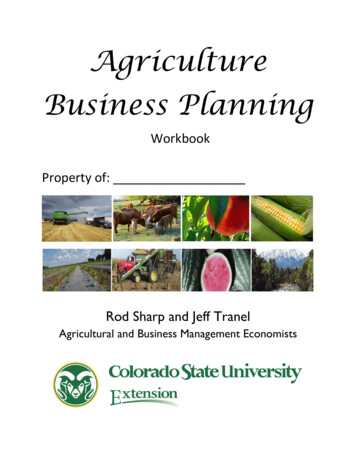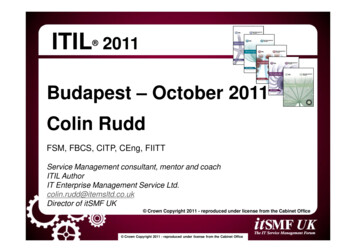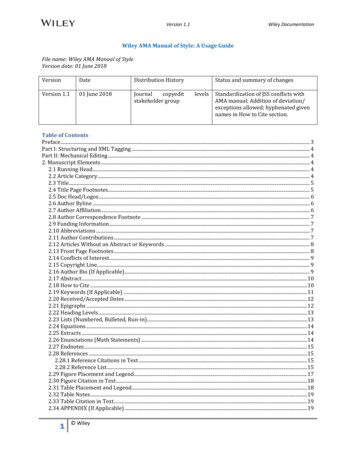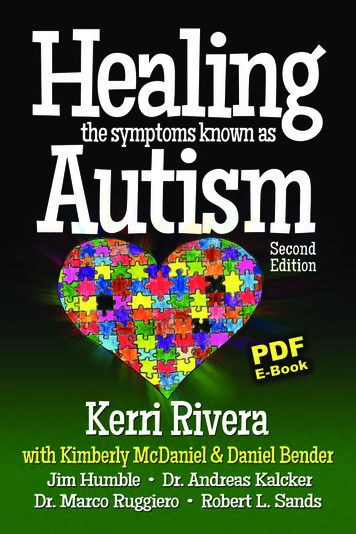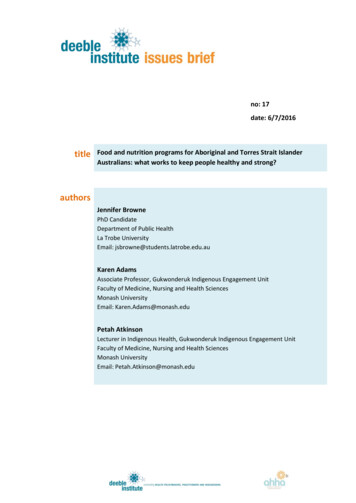
Transcription
no: 17date: 6/7/2016titleFood and nutrition programs for Aboriginal and Torres Strait IslanderAustralians: what works to keep people healthy and strong?authorsJennifer BrownePhD CandidateDepartment of Public HealthLa Trobe UniversityEmail: jsbrowne@students.latrobe.edu.auKaren AdamsAssociate Professor, Gukwonderuk Indigenous Engagement UnitFaculty of Medicine, Nursing and Health SciencesMonash UniversityEmail: Karen.Adams@monash.eduPetah AtkinsonLecturer in Indigenous Health, Gukwonderuk Indigenous Engagement UnitFaculty of Medicine, Nursing and Health SciencesMonash UniversityEmail: Petah.Atkinson@monash.edu
ContentsAcknowledgments. 1Executive summary . 2Key Recommendations . 31. Introduction . 4Understanding the issue . 4Understanding the evidence . 5The need for a new approach . 62. The Policy Context. 73. What works? Lessons from food and nutrition programs for Aboriginal and Torres Strait Islanderpeoples . 9Maternal Health and Parenting . 10Childhood health and development . 11Adolescent and youth health . 12Healthy Adults . 13Healthy Ageing . 144. How should programs be developed and implemented? . 155. Recommendations for policy and practice . 17Key Readings and references . 18
AcknowledgmentsThis issues brief was developed as part of a Writing for Policy scholarship prize administered bythe Deeble Institute for Health Policy Research, Australian Healthcare and Hospitals Association(AHHA), Canberra. The authors would like to thank Susan Killion (Director, Deeble Institute), DrMark Lock (ARC Discovery Indigenous Research Fellow, University of Newcastle) and Dr DeborahGleeson (Lecturer in Public Health, La Trobe University) for their invaluable assistance andsupport in developing this issues brief. The authors would also like to acknowledge the NationalAboriginal Community Controlled Health Organisation (NACCHO) for their contribution to thiswork.1
Executive summaryMore effective action is urgently required in order to reduce the unacceptablehealth inequalities experienced by Aboriginal and Torres Strait Islander peoples.Food insecurity and nutrition-related chronic conditions are responsible for a largeproportion of the ill-health experienced by Australia’s First Peoples who, beforecolonisation, enjoyed physical, social and cultural wellbeing for tens of thousands ofyears. Food and nutrition programs, therefore, play an important role in the holisticapproach to improving health outcomes for Aboriginal and Torres Strait Islanderpeoples.The National Aboriginal and Torres Strait Islander Health Plan takes a “whole-of-life”approach to improving health outcomes. Priority areas include maternal health andparenting; childhood health and development; adolescent and youth health; healthyadults and healthy ageing. This Policy Issues Brief provides a synthesis of theevidence for food and nutrition programs at each of these life stages. It answersquestions such as, what kind of food and nutrition programs are most effective forAboriginal and Torres Strait Islander peoples? And, how should these food andnutrition programs be developed and implemented?Nutrition research has been criticised for focusing too much on quantifying dietaryrisks and deficits, without offering clear solutions. Increasingly, Aboriginalorganisations are calling for strength-based approaches, which utilise communityassets to promote health and wellbeing. Evidence-based decision-making mustconsider not only what should be done, but also how food and nutrition policies andprograms can be developed to support the existing strengths of Aboriginal andTorres Strait Islander communities.The evidence suggests that the most important factor determining the success ofAboriginal and Torres Strait Islander food and nutrition programs is communityinvolvement in (and, ideally, control of) program development and implementation.Working in partnership with Aboriginal or Torres Strait Islander health professionalsand training respected community members to deliver nutrition messages areexamples of how local strengths and capacities can be developed. Incorporation ofAboriginal and Torres Strait Islander knowledge and culture into program activities isanother key feature of strength-based practice which can be applied to food andnutrition programs.2
Key Recommendations1.Consistent incorporation of nutrition and breastfeeding advice into holistic maternaland child health care services.2.Creation of dedicated positions for Aboriginal or Torres Strait Islander people to betrained and supported to work with their local communities to improve food securityand nutrition.3.Development of strategies which increase access to nutritious food, such as mealprovision or food subsidy programs, should be considered for families experiencingfood insecurity.4.Adoption of settings-based interventions (e.g. in schools, early childhood servicesand sports clubs) which combine culturally-appropriate nutrition education withprovision of a healthy food environment.3
1. IntroductionThis year marked the ten-year anniversary of the Close the Gap campaign for Aboriginal andTorres Strait Islander health equality. The goal of this campaign is to close the lifeexpectancy gap between Aboriginal and Torres Strait Islander peoples and other Australians;a gap which is currently estimated to be 10 years (ABS 2014). The campaign, which is led byAboriginal and mainstream peak health and social justice organisations, pursues a humanrights-based approach to achieving health equality within a generation (Aboriginal andTorres Strait Islander Social Justice Commissioner 2005).Approximately 80% of the gap in mortality between Aboriginal and Torres Strait Islanderpeople and non-Indigenous Australians is due to preventable chronic conditions such ascardiovascular disease, type 2 diabetes, cancers and kidney failure (AHMAC 2014). Diet andnutrition as part of holistic wellbeing have an important role to play in preventing theseconditions. For example, obesity is responsible for two-thirds of the burden of disease dueto diabetes and one-third of the cardiovascular disease burden in the Aboriginal and TorresStrait Islander population (Vos et al. 2003). Obesity and other dietary factors are now theleading contributors to burden of disease in Australia (Institute of Health Metrics andEvaluation 2013). Thus improving nutrition should be an essential component of preventingchronic disease in the Aboriginal and Torres Strait Islander population.This issues brief will present a synthesis of the evidence about Aboriginal and Torres StraitIslander food and nutrition, with the aim of providing evidence-based recommendationsabout:o “what works” in relation to food and nutrition programs for Aboriginal andTorres Strait Islander communitieso “how to” develop and implement Aboriginal and Torres Strait Islander food andnutrition programs in an effective and appropriate manner to maximise thelikelihood of success.Understanding the issueNutrition is a key determinant of good health throughout life. It is essential to healthy foetaldevelopment, child growth and protection of health (NHMRC 2013). In addition, foodprovides important social and cultural functions, and access to adequate food is considereda basic human right (UN 1966).4
Poor nutrition is rapidly becoming the most important factor contributing to adverse healthoutcomes in Australia. Dietary risks and overweight/obesity are now the leading causes ofillness and death for all Australians, respectively accounting for 11% and 9% of the totaldisease burden (AIHW 2014). The total burden of disease attributable to dietary factors hasnot yet been calculated for Aboriginal and Torres Strait Islander Australians; however, it hasbeen suggested that diet contributes to almost one-quarter of the disease burdenexperienced by Australia’s First Peoples (Lee et al. 2013).Before colonisation, a hunter-gatherer lifestyle sustained the good health of Aboriginal andTorres Strait Islander peoples for tens of thousands of years (Fredericks 2013). This diet wasmade up of unprocessed plant foods and undomesticated animals, and had a nutrientprofile consistent with current dietary recommendations (O’Dea 2005). It is believed thatthis diet, together with high levels of physical activity and social wellbeing, protectedAboriginal and Torres Strait Islander peoples from the obesity and chronic diseases whichare common today.With colonisation came massacre, infectious disease and destruction of the traditional foodhabits and hunter-gatherer way of life. Aboriginal and Torres Strait Islander peoples wereforcibly removed from ancestral lands, and made to live on reserves and missions, wherenutritious diets were replaced with rations of flour, sugar, tea and fatty meat (Shannon2002). Colonisation and the disruption of traditional societies and imposition of Westerndietary patterns underpin the high prevalence of diet-related disease that many Aboriginaland Torres Strait Islander people experience today (Gracey 2002).Despite this history, Australia’s First Peoples are strong and resilient and are the world’slongest-surviving culture (Rasmussen et al. 2011). Aboriginal and Torres Strait Islanderpeoples continue cultural practices, contributing to Australia’s rich diversity, from which allcan citizens benefit.Understanding the evidenceThe current access issues to health and nutrition experienced by Aboriginal and Torres StraitIslander peoples must be understood in the context of Australia’s colonial history and theongoing issues of racism and socioeconomic inequality. Diet is more than a lifestyle choice;it is determined by the availability of and access to healthy food, and by having theinfrastructure, knowledge and skills to prepare food appropriately (WHO 1996).Food insecurity underlies much of the diet-related disease in Aboriginal and Torres StraitIslander communities. The most recent National Health Survey revealed that approximately5
one-quarter (23%) of Aboriginal and Torres Strait Islander people had run out of food in theprevious year, compared with less than one in 20 (3.7%) in the non-Aboriginal population(ABS 2015). This is partially explained by the fact that Aboriginal and Torres Strait Islanderhouseholds have, on average, a weekly gross income which is 250 less than that of nonIndigenous households (AIHW 2015).The availability of nutritious foods, particularly fruit and vegetables, is inadequate in manyremote communities (COAG 2010). It is also well documented that the cost of basic healthyfoods has been progressively rising in Australia, with prices significantly higher in rural andremote areas (Harrison et al. 2010; ABS 2015b). Low-income households are forced tospend 30-40% of their weekly income on food to meet nutritional requirements (Harrison etal. 2010; Lee et al. 2011; Barosh et al. 2014).The limited availability and affordability of healthy food for many Aboriginal and TorresStrait Islander families is reflected in national nutrition survey data. Fewer than half meetthe recommendations for daily fruit intake, and only around one in 20 consume therecommended five serves of vegetables each day (ABS 2014). Instead, it is estimated that41% of daily energy intake is derived from energy-dense, “discretionary” foods (ABS 2015),which provide a cheaper source of calories (Brimblecombe & O’Dea 2009).Food insecurity is associated with obesity and type 2 diabetes (Burns 2004; Seligman 2007).Results from the 2012-13 National Aboriginal and Torres Strait Islander Health Surveyrevealed that approximately 70% of adults had a high waist circumference. Furthermore,one in 10 adults had diabetes, a prevalence three times higher than that in the nonIndigenous population (ABS 2013). Aboriginal and Torres Strait Islander Australians developdiabetes 20 years earlier than other Australians (ABS 2014), which increases the likelihoodof complications of the disease developing (Song & Hardisty 2009).The need for a new approachIndigenous health research has been criticised for the predominance of descriptive studieswhich do not improve health outcomes for the communities involved (Sanson-Fisher et al.2006). Specifically, it has been suggested that nutrition research focuses too much onquantifying diet-related problems, without offering or evaluating clear solutions (Foley &Schubert 2012). While epidemiological research is necessary in order to inform policymakers about population health and the determinants of health inequalities, Brough et al.(2004) caution that focusing only on risks and deficits can reinforce negative stereotypesabout Aboriginal and Torres Strait Islander peoples. Opportunities also exist to utilisecommunity strengths in policy and program development (Bond 2009). A strength-based6
approach reframes the focus of public health and health promotion from “what’s wrongwith people?” to “what keeps people healthy?” (Bengel et al. 2001).Strength-based approaches are advocated by Aboriginal and Torres Strait Islanderorganisations (National Congress of Australia’s First Peoples 2012) and research centres(Lowitja Institute 2016), as well as by previous evidence reviews (Osborne, Baum & Brown2012). Such an approach underpins the current National Aboriginal and Torres StraitIslander health Plan (Department of Health and Ageing 2013). However, there is a limitedevidence base for strength-based approaches to improving food and nutrition, and it is notclear how these approaches can be effectively implemented in Aboriginal and Torres StraitIslander communities (Foley & Schubert 2012).While systematic reviews provide a rigorous method for appraising relevant researchevidence, it has been suggested that they are not always appropriate in Aboriginal healthresearch (McDonald et al. 2010). The restrictive inclusion criteria in conventional systematicreviews often mean that only a very limited number of papers are considered. This processusually privileges experimental study designs and excludes qualitative research. However,qualitative research also makes a valuable contribution to evidence and decision-making inAboriginal and Torres Strait Islander health, as this form of evidence is more likely to conveyIndigenous perspectives about health programs and community strengths (Foley & Schubert2012). Including a broader range of study designs can help to identify interventions whichare not only effective, but are also engaging and empowering for Aboriginal and TorresStrait Islander peoples. For this reason, both quantitative and qualitative evidence havebeen considered in the development of this issues brief.2. The Policy ContextAboriginal and Torres Strait Islander health equality has been a prominent policy issue forthe past decade. The Close the Gap public awareness campaign, which began in 2006,brought the issue of the life expectancy gap to the nation’s attention, and urged all levels ofgovernment to commit to ending the health disparities faced by Aboriginal and Torres StraitIslander Australians. In response to this campaign, in December 2007 the Council ofAustralian Governments (COAG) agreed to a new policy goal of Closing the Gap inIndigenous Disadvantage. The COAG commitments included the specific targets of “closingthe life expectancy gap within a generation” and “halving the mortality gap for childrenunder five within a decade” (COAG 2007, p.3).7
In 2008, the Close the Gap campaign partners came together at the National IndigenousHealth Equality Summit. They developed a detailed set of targets which they considered tobe necessary for achieving COAG’s health commitments. Among these was a food andnutrition target, which proposed that greater than 90% of Aboriginal and Torres StraitIslander families should be able to access a standard healthy food basket for less than 25%of their available income (Steering Committee for Indigenous Health Equality 2008). ThisSummit culminated in the signing of the Close the Gap Statement of Intent, in which bothmajor political parties, many peak health organisations and the Aboriginal communitycontrolled sector all agreed to work together to achieve health equality by the year 2030(Human Rights and Equal Opportunity Commission 2008).Over the next few months, COAG developed a National Indigenous Reform Agenda, brandedClosing the Gap, which committed Federal, State and Territory Governments to agreedobjectives, outputs and performance indicators for improving outcomes for Aboriginal andTorres Strait Islander peoples. One of the agreed indicators for closing the life expectancygap is the prevalence of overweight and obesity (COAG 2011). By 2009, eight Indigenousspecific National Partnership Agreements had been signed, and 4.6 billion was invested toimprove health and its social determinants, such as housing, employment, education andearly childhood development (COAG 2011). A National Strategy for Remote Indigenous FoodSecurity was added to the COAG agenda in December 2009 (COAG 2009). While theprogress of the National Indigenous Reform Agreement continues to be monitored, all ofthe Closing the Gap National Partnership Agreements have now expired.The current policy framework for improving Aboriginal and Torres Strait Islander health andmeeting the COAG health targets is the National Aboriginal and Torres Strait Islander HealthPlan. Improving food access and nutrition was identified as key strategy within the 10-yearhealth plan (Department of Health and Ageing 2013, p.29) which was developed followingextensive community consultation. The Health Plan takes a “whole-of-life” approach, aimingto reduce risk factors and improve health outcomes across the life course. Priority areasinclude maternal health and parenting; childhood health and development; adolescent andyouth health; healthy adults and healthy ageing (Department of Health and Ageing 2013).Nutrition has an important role to play at each of these life stages.The recently-published implementation plan (Department of Health 2015) also prioritisesnutrition, especially for infants, children and pregnant women; however, specific strategiesare yet to be defined. Instead, the Commonwealth has committed to undertaking a“Nutrition Framework Gap Analysis” in order to identify actions to address various food andnutrition issues, including food security and maternal and child nutrition (Department of8
Health 2015, p.12). Governments clearly recognise the importance of food and nutrition tothe health of Australia’s First Peoples in policy documents. Despite this, there was nomention of Aboriginal and Torres Strait Islander nutrition programs or funding in therecently announced 2016-17 Commonwealth Budget (Department of Health 2016). Therecent Redfern Statement published by Aboriginal and Torres Strait Islander leadersreaffirmed the need for urgent government action in order to improve health and socialjustice for First Peoples.There is an abundance of data describing the “problems” associated with poor nutrition;however, clear policy “solutions” are more difficult to articulate. Evidence-basedinformation is required in order to determine not only what should be done, but also howfood and nutrition policies and programs can be developed to support the existing strengthsof Aboriginal and Torres Strait Islander communities. This will enable policymakers toimplement food and nutrition initiatives which are both effective and appropriate to thecontext.3. What works? Lessons from food and nutrition programs forAboriginal and Torres Strait Islander peoplesThis section provides an overview of previous reviews of interventions which aimed toimprove nutritional status or diet-related health outcomes for Aboriginal and Torres StraitIslander peoples. The findings have been organised into the key life stages prioritised withinthe National Aboriginal and Torres Strait Islander Health Plan (Department of Health 2013 &2015). As noted above, these are maternal health and parenting; childhood health anddevelopment; adolescent and youth health; healthy adults and healthy ageing. For each ofthese life stages, quantitative and qualitative literature has been reviewed in order toanswer the following questions:o What kind of food and nutrition programs are most effective for Aboriginal andTorres Strait Islander peoples?o How should food and nutrition programs for Aboriginal and Torres Strait Islanderpeoples be developed and implemented?9
Maternal Health and ParentingTwo reviews have been undertaken which specifically examined Aboriginal and Torres StraitIslander maternal and child health interventions (Herceg 2006; Jongen et al. 2014). The firstof these (Herceg 2006) was commissioned by the Office of Aboriginal and Torres StraitIslander Health in order to inform the development of a maternal and child health policy.This review identified numerous examples of successful community-based mother and babyprograms published between 1993 and 2004. While these programs varied in scope, severaldemonstrated improvements in infant birthweights (e.g. d’Espaignet et al. 2003; Carter etal. 2004), and several reported success in promoting breastfeeding (Engeler 1998). Thereview concluded that flexible, community-based and/or community-controlled pregnancyand postnatal care services which respect Aboriginal and Torres Strait Islander people,families and culture were more likely to improve health outcomes. Having an appropriatelytrained workforce which values Aboriginal and Torres Strait Islander staff was alsoconsidered a key element of successful programs (Herceg 2006).A more recent systematic review (Jongen et al. 2014) provided updated information aboutmaternal and child health programs in Aboriginal and Torres Strait Islander primary healthcare settings. The review further highlighted the promise of community-based andcontrolled antenatal and postnatal care programs for Aboriginal and Torres Strait Islanderfamilies. The most common program component identified in more recent literature washealth promotion/education and advice/support, with nutrition and breastfeeding amongthe most common health promotion topics. While improvements in birth weights,breastfeeding rates and nutritional status were reported in some evaluations ofgovernment-funded maternal and child health programs (e.g. OATSIH 2005; Murphey &Best 2012), the reviewers advised that it was not possible to prove any “cause and effect”relationships, due to the variable quality of program documentation and evaluationmethods (Jongen et al. 2014).The Strong Women, Strong Babies, Strong Culture program stands out as the exemplarmaternal and child nutrition initiative identified in both reviews. This community-initiatedprogram has been implemented in multiple communities in the Northern Territory andremote Western Australia. The program used a peer-education model, in which seniorwomen in the community provided nutrition assessment, education and advice to youngerpregnant women, along with cultural activities and health promotion messages abouttobacco, alcohol and antenatal care. In the Northern Territory, the program producedsignificant improvements in mean birthweights (Mackerras 2001; d’Espaignet et al. 2003),while in Western Australia, the introduction of growth assessment and infant feeding advice10
resulted in improved infant growth after 6 months of age (Smith et al. 2000). It has beennoted that the program has been more successful in some communities than others, whichfurther highlights the importance of documenting how program components areimplemented (Herceg 2006).Childhood health and developmentInterventions to improve child nutrition and growth were considered in the review byHerceg (2006), as well as in a systematic review specifically looking at interventions toprevent growth faltering among Aboriginal and Torres Strait Islander children (Macdonald etal. 2008). Both reviews provided evidence, based on a small number of studies in remotecommunities, that community-based nutrition programs, which combine nutritioneducation with other strategies such as growth monitoring and food provision, can improvegrowth and prevent hospital admissions. Macdonald et al. (2008) emphasised theimportance of involving carers, health workers and local community members in thedevelopment of nutrition programs, and of ensuring that these interventions are integratedinto primary health care systems and address the underlying causes of growth problems.Food insecurity is one potential cause of child nutrition and growth problems. To addressthis, food supplementation was a component of some child nutrition programs reported inthe literature (e.g. Coyne 1980; Warchivker 2003). Systematic reviews of supplementaryfeeding programs have demonstrated that the majority of research has been undertaken inlow and middle-income countries (MacDonald et al. 2006; Kristjansson et al. 2015). A recentCochrane review concluded that supplemental feeding programs can improve growth andpsychomotor development, and that programs were more effective when supplementaryfood was provided at day care centres rather than at home (Kristjansson et al. 2015). Thereviewers noted that the only effective study from a high-income country involvedAboriginal children who received hot meals and nutritious snacks when attending preschool (Coyne 1980). Macdonald et al. (2006; 2008) cautioned that feeding programs shouldonly be implemented when food insecurity is a major issue and when the local communitysupports such programs.Food subsidy programs are another strategy which has been used to address food securityfor disadvantaged families in the United States (Black et al. 2012). Reviews of Aboriginal andTorres Strait Islander nutrition programs have highlighted successful subsidy programs forAboriginal families experiencing food insecurity (Browne et al. 2009; Murray et al. 2014;Gwynn et al. 2015). The Bulgarr Fruit and Vegetable Program provided a weekly box ofsubsidised fruit and vegetables to families whose children were attending any one of three11
local Aboriginal Medical Services for health assessments. Families made a co-payment of 5for the fruit and vegetable box, which was worth 40- 60 depending on the number ofchildren. After 12 months, the subsidy program improved the nutritional status and shortterm health outcomes of participating children (Black et al. 2013a; 2013b).Overweight and obesity is another issue which disproportionately affects Aboriginal andTorres Strait Islander children (ABS 2013a). One systematic review has attempted toexamine the effectiveness of interventions to prevent childhood obesity among Indigenouschildren; however, no studies based in Aboriginal or Torres Strait Islander communitieswere identified in the literature (Laws et al. 2014). The only two Indigenous health programsincluded in the review were both from North America, and involved home visits. Evaluationof a 16-week home visiting parenting support program delivered by an Indigenous peereducator demonstrated improvements in feeding practices, energy intake and promisingresults in relation to preventing obesity (Harvey-Berino 2003). It has also been suggestedthat comprehensive whole-of-community nutrition programs (see “Healthy Adults” sectionbelow) may positively impact childhood obesity rates (Closing the Gap Clearinghouse 2012)Adolescent and youth healthThe evidence regarding effective food and nutrition programs for Indigenous young peopleis very limited. A recent systematic review explored this topic; however, no Australianstudies were identified in the peer-reviewed literature (Antonio et al. 2015). The sixinterventions reviewed were all undertaken with American Indian and Canadian Aboriginalpopulations, and community participation was a feature of all programs. Most studies in thisreview evaluated lifestyle education programs, delivered in school or community settings.The authors noted: “interventions with the curricula based on the Indigenous culturetended to report favourable outcomes for diet,
The National Aboriginal and Torres Strait Islander Health Plan takes a whole-of-life approach to improving health outcomes. . (ABS 2014). The campaign, which is led by . Diet and nutrition as part of holistic wellbeing have an important role to play in preventing these conditions. For




